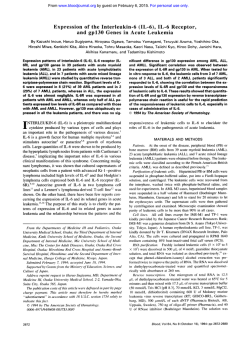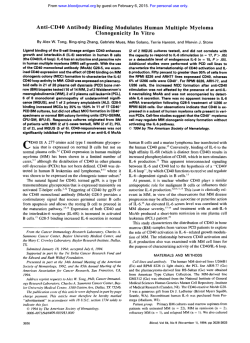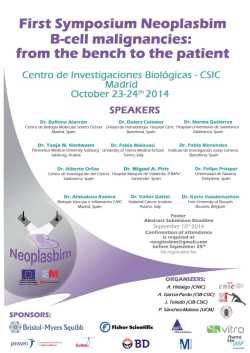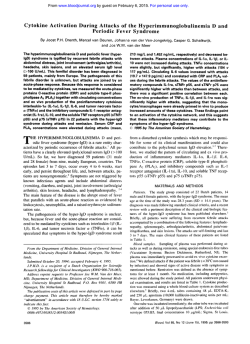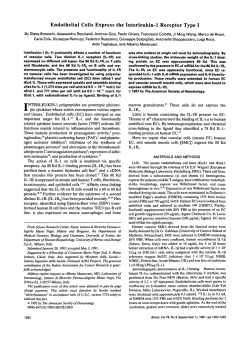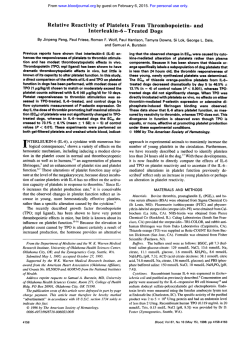
Characterization of an Interleukin-6-Mediated Autocrine
From www.bloodjournal.org by guest on February 6, 2015. For personal use only. Characterization of an Interleukin-6-Mediated Autocrine Growth Loop in the Human Multiple Myeloma Cell Line, U266 By Gisela Schwab, Clay E. Siegall, Lucien A. Aarden, Leonard M. Neckers, and Richard P. Nordan It has been reported recently that freshly isolated human myeloma cell cultures proliferate in response to added interleukin-6 (IL-6). Endogenous levels of IL-6 found in the same cultures suggested that an autocrine growth loop may contribute to cell growth. However, the lack of homogenous cell populations in primary myeloma cultures has made it difficult to distinguish between paracrine and autocrine growth mechanisms. To precisely address the autocrine growth issue we have evaluated the growth of the human myeloma cell line, U266. We have found that a neutralizing anti-IL-6 monoclonal antibody can inhibit U266 proliferation. Furthermore, the addition of IL-6 antisense oligonucleotides also inhibits U266 proliferation.These effects are reversed by adding IL-6, suggesting the presence of an autocrine loop. Using bioassays with two different IL-Mependent cell lines, we were able to detect IL-6 in concentrated U266 supernatants. IL-6 mRNA was detected by polymerase chain reaction amplification of cDNA. Cell cycle parameter analysis shows that IL-6 acts to release a block in G1. Taken together these results present conclusive evidence for I L - h e d i a t e d autocrine growth in the U266 human myeloma cell line. This is a US government work. There are no restrictions on is use. I directed against human IL-2, was purchased from Genzyme (Boston, MA). Plasmid pIL-6 was purchased from British Biotechnologies Limited (Oxford, UK) and carries a synthetic gene for IL-6 inserted between the Hind111 and EcoRI sites in the polylinker of pUC 18. Cell culture. U266pl (referred to as U266), a human myeloma cell line, and T24, a human bladder carcinoma line, were obtained from the American Type Culture Collection (Rockville, MD). CHP100, a human neuroepithelioma line, was kindly provided by Dr Angelo Rosolen (National Cancer Institute, Bethesda, MD). B9, an IL-&dependent B-cell hybridoma, has been described previously.I67TD1, another IL-&dependent B-cell hybridoma cell line, was a kind gift from J. Van Snick.I7All cells were maintained in complete medium that consisted of RPMI 1640, 10% heatinactivated fetal calf serum (FCS), 50 mmol/L 2-mercaptoethanol, and 50 KgImL gentamycin. In addition, the IL-6-dependent B9 and 7TD1 cells were maintained in medium supplemented with rIL-6. IL-6 bioassays. Culture supernatants were evaluated for IL-6 activity using the B9 and 7TD1 hybridoma growth factor assay^.'".'^ Briefly, 2,000 B9 or 7TD1 cells in a final volume of 200 pL of complete medium (no IL-6) were cultured with serial dilutions of the test sample. After 85 hours the B9 assays were pulsed with 0.5 pCi 'H-thymidine per well for 4 hours, harvested over glass fiber filters, and counted in a liquid scintillation spectrophotometer. In the 7TD1 assays the wells were pulsed with 20 KL of 3-4.5dimethylthiazol-2.5-diphenyltetrazoliumbromide (MTT) at a concentration of 5 mg/mL for 4 hours at 37"C, and then further processed as previously described.'* Briefly, the cells were pelleted in the wells and resuspended in 200 pL of dimethyl sulfoxide. The samples were then read on an enzyme-linked immunosorbent assay reader at 540-nm and 690-nm wavelengths. The absorbance values in this assay closely correlated with the growth of the 7TDl cells. In these assays one hybridoma growth factor (HGF) unit represents NTERLEUKIN-6 (IL-6), also known as interferon p2, B-cell stimulatory factor-2, or plasmacytomabybridoma growth factor, has multiple biologic activities. It has been shown to induce B-cell maturation,'.' growth and differentiation of T cell^^^ and has multi-colony-stimulating factor activity on hematopoietic progenitor cells: IL-6 has also been shown to induce the differentiation of myeloid cells' and nerve cells,' and is responsible for the production of acute-phase proteins in In addition to its activity on normal cells, IL-6 is necessary to sustain the in vitro growth of many murine plasmacytomasll.'z and has been shown to enhance the proliferation of freshly explanted human myeloma cells." The hypothesis that IL-6 can also support myeloma cell growth in vivo is supported by the observation that myelomas arise in or are found in environments that contain cells which produce IL-6 in Recently, Kawano et all3 found measurable concentrations of IL-6 in cultures of freshly explanted myeloma cells as well as cell surface expression of the p80 chain of the IL-6 receptor. They also showed that inhibition of the endogenously produced IL-6 with polyclonal antibodies could inhibit the proliferation of some freshly cultured myelomas, and suggested that an autocrine mechanism may account for the myeloma cell proliferation. However, in a similar study, Klein et all4 were unable to verify the autocrine hypothesis in human myeloma and assigned the in vitro production of IL-6 to contaminating adherent cells from the bone marrow rather than to the myeloma cells themselves. Thus, according to Klein et al,I4human multiple myeloma growth is regulated in a paracrine rather than an autocrine manner. Although paracrine growth remains a likely mechanism for many myelomas, in this report we present data on the human multiple myeloma cell line, U266, that clearly show the existence of IL-&driven autocrine growth. MATERIALS AND METHODS Reagents. Moloney murine leukemia virus (M-MLV) reverse transcriptase was obtained from Bethesda Research Laboratories (Gaithersburg, MD). Taq DNA polymerase was purchased from Perkin Elmer-Cetus (Norwalk, a). Recombinant human IL-6 (rIL-6) was obtained from R&D Systems (Minneapolis, MN). CLB.IL618 is a murine monoclonal antibody (MoAb) (IgG,, K) directed against human IL-6.I5 DMS 1, a murine MoAb (IgG,, K) Blood, Vol77, No 3 (February 1). 1991: pp 587-593 From the Tumor Cell Biology Section, Medicine Branch and Laboratory of Molecular Biology, National Cancer Institute, National Institutes of Health, Bethesda, MD; and the Central Laboratory of the Red Cross Blood Transfusion Service, Amsterdam, The Netherlands. Submitted March 23, 1990; accepted October 3, 1990. Address reprint requests to Richard P. Nordan, PhD, Medicine Branch, Bldg 10, Room 12N234, National Cancer Institute, NIH, Bethesda, MD 20892. The publication costs of this article were defrayed in part by page charge payment. This article must therefore be hereby marked "advertisement" in accordance with 18 U.S.C. section 1734 solely to indicate this fact. This is a USgovemment work. There are no restrictions on its use. 0006-4971I9117703-0015$0.0010 587 From www.bloodjournal.org by guest on February 6, 2015. For personal use only. 588 SCHWAB ET AL the half maximal growth response of the IL-Mependent cells and is equivalent to approximately 1pg/mL of native IL-6. Cell cycle analysis. Test cells were harvested, washed in phosphate-buffered saline (PBS), and futed in 50% cold ethanol for 1 hour on ice. After pelleting, the cells were resuspended in RNase A solution (580 U/mL PBS) and incubated for 30 minutes at 37°C. Equal volumes of 0.005% propidium iodine were added. After a 20-minute incubation at room temperature, cell cycle analysis was performed using a FACSstar flow cytometer (B-D Immunocytometry Systems, Mountain View, CA) as previously described.I9 Oligodeoynucleofidesfor in vitro assays. Fifteen-base sequences from three different regions of the IL-6 cDNA’ were chosen for the production of antisense, sense, or random oligodeoxynucleotide (Fig 1). Random oligonucleotide sequences of the same base composition as the antisense oligomers were used as controls. Region I spanned the transcriptional start site. Region I1 was downstream and immediately adjacent to region I, and region 111 corresponded to an area in the second exon of the IL-6 gene that had previously been described as an effective antisense sequence in reducing growth and IL-6 production in Kaposi sarcoma cells.” The oligonucleotides were synthesized by cyanoethyl phosphoramidite methodology using an Applied Biosystems Model 380 B DNAsynthesizer (Foster City, CA). An aliquot of each sample was analyzed for homogeneity on a 15% polyacrylamide denaturing gel. The oligomers were ethanol precipitated, washed with 70% ethanol, and subjected to three sequential cycles of sterile water resuspension and lyophilization. cDNA amplijicafion using the polymerase chain reaction (PCR). Poly A selected RNA was prepared using the guanidine isothiocyanatekesium chloride method,21.” followed by poly-A-selection on an oligo-dT column. The first strand of cDNA was synthesized using random hexamers and M-MLV reverse transcriptase. 24mer oligodeoxynucleotide primers which flanked 639 bases of the mature IL-6 message spanning five exons and four introns in the IL-6 gene were synthesized by the cyanoethyl phosphoroamidite methodology. cDNA was amplified using taq polymerasez3 on a Perkin Elmer-Cetus thermocycler for 30 cycles with cycles designed as follows: denaturation at 94°C for 1minute, annealing at 42°C for 2 minutes, and polymerization at 72°C for 3 minutes with 10 seconds of extension time in each cycle. An aliquot of each sample was analyzed on a 1% agarose gel. Amplified DNA could be detected at the expected size by ethidium bromide staining of the gel. Subsequently, the samples were transferred to nitrocellulose and hybridized with a 3zP-labeled IL-6 probe (HindIII-EcoRI insert of pIL-6) prepared by nick translation. The signal was detected by autoradiography. RESULTS Production of IL-6 by U266 cells. In searching for IL-6-mediated autocrine growth we initially asked if U266 myeloma cells produced biologically active IL-6. Conditioned medium was collected at various times from U266 cells growing at densities ranging from 0.2 to 1.5 x lo6 cells/mL and analyzed in the B9/HGF assay. IL-6 was not detected in any of the neat supernatants. However, after a 20-fold concentration, IL-6 could be detected at concentrations of 5 to 20 HGF U/mL in bioassays using either of the IL-&dependent cell lines, B9 or 7TD1. In the neat supernatants this corresponds to approximately 0.5 to 2 HGF U/mL, which corresponds to 0.5 to 2 pg/mL of IL-6. Specificity of the IL-&dependent support of B9 or 7TD1 cells was proven by inhibition of the supernatant-mediated growth with CLB.IL6/8, a neutralizing anti-IL-6 MoAb (Table 1). Inhibition of U266 proliferation with anti-IL-6. To test whether the endogenously produced IL-6 was acting as an autocrine growth factor, the neutralizing MoAb CLB.IL6/8 was added directly to U266 cultures. As measured by ’H-thymidine incorporation, a 70% inhibition of U266 proliferation was obtained with 10 g / m L CLB.IL6/8 (Fig 2). Partial inhibition of U266 proliferation was observed with antibody concentrations as low as 0.1 p.g/mL. This effect was reversible by adding excess IL-6. The addition of CLB.IL6/8 also prevented increases in cell numbers but did not result in cell death, even after 5 days of incubation at 50 pg/mL (data not shown), suggesting that IL-6 is necessary for U266 proliferation but not for the maintenance of viability. In our hands 1 pg/mL of CLB.IL6/8 completely neutralized 20 HGF U of IL-6 in the B9 assay. The monoclonal murine antibody DMSl that was used as a control did not affect ’H-thymidine uptake of U266 cells. We also evaluated the effect of CLB.IL6/8 inhibition on U266 cell cycle parameters. As shown in Fig 3, anti-IL-6treated U266 cells displayed a 50% reduction of cells in the S phase of the cell cycle (P < .001). This was accompanied by an accumulation of cells in GI (P < .Ol), indicating that U266 cells encounter a G, block in the absence of IL-6. Detection of IL-6 message in U266 cells. We attempted to evaluate the level of IL-6 mRNA using Northern blot and RNase protection assays. Although others have reported the presence of IL-6 message in U266 cell^,^'^^^ we were unable to detect IL-6 message in poly A-selected U266 RNA (data not shown) using these methods. PCR amplification of cDNA, a more sensitive assay for the detection of specific mRNAs, was performed. First-strand IL6 messenger RNA ATG Region: Antisense: I GGAGlTCATAGCTGG Sense: CCAGCTATGAACTCC Random: TGTCGGAGTCGTGAA II 111 CTTACTTGTGGAGAA TCCTGGGGGTACTGG ND TCTCATGTTAGGAGA ND CTCGTGTGGACGGGT Fig 1. Schematic illustration of location and sequence of the oligodeoxynucleotides used. From www.bloodjournal.org by guest on February 6, 2015. For personal use only. 589 IL-MEDIATED AUTOCRINE GROWTH IN U266 MYELOMA Table 1. EndogenousProduction of 11-6 by U266 Sample 69 assay Expt 1 Expt 2 7TDl assay Expt 1 Expt 2 Expt 3 Expt 4 U266 Medium RPMl 1640 + 10% FCS u266 Medium + Anti-lL-6 2 1 0.5 0.5 0.5 0.25 0 0 0 0 0 0 ND 0 ND 0 0 ND Values are HGF units per milliliter. Productionof IL-6by U266 cells. 69 or 7TDl cells were cultured in triplicate with serial dilutions of 20-fold concentrated U266 conditioned medium in presence or absence of 10 pg/mL of the monoclonal anti-IL-6 antibody CLB.IL6/8. Twentyfold concentrated RPMl 1640 with 10% FCS served as control. Results were corrected to reflect the IL-6activity present in the neat supernatant. Abbreviations: Expt, experiment; ND, not done. cDNAs were synthesized from 1 pg of poly A-selected RNA using reverse transcriptase. Specific primers corresponding to the 5' and 3' ends of the mature IL-6 message were used in the PCR reaction to amplify the IL-6 cDNA. This reaction produced the 639-bp fragment predicted for the IL-6 cDNA using these primers (Fig 4). The same fragment was generated using T24 bladder carcinoma cells, which have been shown to express IL-6 message,= whereas no detectable fragment was generated using CHP100, a neuroepithelioma. Effect of treatment with IL-6 antisense oligodeoxynucleotides. To establish whether IL-6 antisense oligodeoxynucleotides can be used to inhibit the growth of autocrine myeloma cells, we cultured U266 with an antisense IL-6 oligomer that spanned the transcriptional start site of the IL-6 message (Fig 1, region I). After 48 hours the growth of mm 0 c n 0) 0 % 0 -m C 0 0 c 0 L. C 0 2 0 n Cell Cycle Phase Fig 3. Effect of anti-lL-6 on U266 cell cycle parameters. U266 cells were cuttured for 2 days with CLB.IL6/8 (monoclonal anti-hll-6) and then analyzed for DNA content using a flow cytometer. Data represent the mean and standard error of three experiments. (m), Control; anti-lL-6.1 pg; (0). anti-ll-6.10 pg. (a), 639 Base Pairs Fig 2. Inhibition of U266 proliferation with anti-ll-6 MoAb. U266 cells were cultured at 5 x l0'lmL in triplicate with 10,OOO HGF U of 11-6 or the indicated concentrations of CLB.IL6/8, a neutralizing monoclonal anti-lL-6 antibody. On days 1through 5 the cultures were pulsed with 3H-thymldineand harvested. Data represent one of four similar experiments. Monoclonal anti-IL-2 antibody of the same 10 pg/mL isotype (DMS1) sewed as a control. (-m-), Control; (.-.O.-.), anti-116; I-.-), 10 pg/mL anti-ll-2; (.-.A,-.), 10 pg/mL anti-ll-6 + IL-6. 4 Fig 4. Detection of lL-6 mRNA First-strand cDNA generated from poly A selected RNA was amplified by PCR using 24mer primers corresponding to amino acids 1through 8 and 206 through 213 of the mature IL-6 protein. PCR products were electrophoresed on a 1% agarose gel, transferred to nitrocellulose, and hybridized with a UP-labeled11-6 probe. Lane 1, control cDNA; lane 2, CHP100; lane 3, U266; lane 4, T24. From www.bloodjournal.org by guest on February 6, 2015. For personal use only. SCHWAB ET AL 590 antisense-treated cells was diminished by 40% when compared with sense-treated or control cells (P < .01) (Fig 5). Analysis of cell cycle parameters showed that treatment with antisense oligodeoxynucleotidesalso resulted in a 40% reduction of cells in S phase (P < .05), whereas sense treatment had no effect (P = .63) (Fig 5). The antisense effect on cell growth and cell cycle parameters could be reversed by adding IL-6 to the cultures. Similar results were obtained in experiments in which the antisense oligomer was added every day for 6 days (data not shown). As with the addition of anti-IL-6, no loss of cell viability was observed. In titration studies of IL-6 antisense oligodeoxynucleotides we saw growth inhibition at concentrations as low as 10 pmol/L oligomer (data not shown). A 15mer of random configuration, but the same base composition as the antisense oligomer to the transcriptional start region, also had no effect on cell growth or distribution of the cells in the cell cycle. We further evaluated the effect of antisense oligonucleotides directed to other regions of the IL-6 cDNA (Fig 6). An antisense 15mer directed against a region of the second exon of the IL-6 gene (Fig 1, region 111) exhibited similar effects on the distribution of cells in S phase and GI phase to those obtained with antisense oligonucleotide against the transcriptional start site of the IL-6 gene (region I). After treatment with this oligomer, U266 cells in S phase decreased by 45% (P < .001) and cells in G, increased by 45% as compared with untreated U266 cells (P < .001). The corresponding random base oligomer did not affect either parameter significantly. An antisense oligonucleotide directed to the region immediately adjacent to and downstream from the transcriptional start site oligomer (Fig 1, region 11) did not exert any effect on cell growth or cell cycle distribution of U266 cells. DISCUSSION The ability of IL-6 to serve as an in vitro growth factor for myelomas has been well documented. Both murine and human iL-Mependent myeloma cell lines have been established in vitro,".11z6and studies with freshly explanted human myeloma cells have shown that IL-6 enhances, in a 4 Cell Count Percenl in S Phase Fig 5. Inhibition of U266 with 11-6 antisense oligodeoxynucleotides. U266 cells were cultured at lO*/mL. Cell counts and percent of cells in S phase of the cell cycle were determined at 2 days after treatment with 100 pmol/L sense or antisense IL-6 oligodeoxynucleotides at 0 and 24 hours. Where indicated, rlL-6 was added at a concentration of 10.000 HGF UlmL. Data represent the mean and standard error of four experiments. (m), Control; (B), sense; (0). antisense; (0). antisense + IL-6. paracrine manner, the in vitro proliferation of some tumor~.".'~ The issue of autocrine growth in myeloma is less clear. Using freshly explanted myeloma cells, Kawano et all3 detected exogenous IL-6 production and mRNA expression and could inhibit the proliferation of some myelomas with anti-IL-6 antibodies. In a similar study Klein et all4were unable to confirm the autocrine hypothesis and attributed the endogenous in vitro IL-6 expression to the presence of contaminating cells. The concept of an autocrine mechanism in tumor development is supported by the studies of Freeman et al? who found IL-6 message expressed in some B-cell lymphomas, but because of the presence of contaminating cells were unable to determine if freshly isolated myeloma cells expressed IL-6 message. In our studies we avoid the issue of contaminating cells by analyzing the human myeloma cell line, U266. In this report we demonstrate the existence of an IL-&mediated autocrine growth loop in U266. Evidence of an autocrine growth loop is provided by the specific inhibition of U266 growth by the monoclonal anti-IL-6 antibody, CLB.IL6/8. When U266 is inhibited with anti-IL-6 the cells accumulate in GI and the proportion of cells in S phase is reduced by 40% to 50%, indicating that these cells encounter a GI block in the absence of IL-6. This observation agrees with experiments in which IL-6 has also been shown to relieve a GIblock in IL-Mependent murine plasmacytomas'' and B-cell hybridoma~.~' It is interesting that unlike the IL-64ependent murine plasmacytomas and hybridomas, which die in the absence of IL-6, the inhibition of U266 does not lead to cell death even with a 100-fold excess of antibody. This suggests either that IL-6 is not required to maintain the viability of U266 or that IL-6 can interact with its receptor in regions that cannot be reached by the antibody, perhaps internally. In either case, if the inhibition of IL-6 does not result in the death of autocrine myeloma cells, the potential therapeutic effectiveness of such reagents against in vivo autocrine tumors will be reduced. The production of IL-6 by U266 was documented using two different highly sensitive IL-Mependent hybridoma cell lines, and this response was specifically inhibited with the monoclonal anti-IL-6 antibody. The accumulated IL-6 reached levels of about 0.5 pg/mL to 2 pg/mL, and could be detected only after concentration of the U266 conditioned medium. These exceedingly low levels of IL-6 would be unable to support most IL-6 responses and raise questions about the level of sensitivity of the U266 myeloma to IL-6. Most cells that exhibit a response to IL-6, eg, IL-6dependent murine plasmacytomas, require levels of native IL-6 that are 100-fold higher than levels required by B-cell hybridomas, such as the B9 and 7TD1 cell lines used in this study (half maximum = 100 v 1 pg/mL). The low levels of IL-6 found in U266 medium might imply that, like B9 and 7TD1, the stimulation of U266 growth occurs at very low concentrations (1 pg/mL) of IL-6. Alternatively, U266 may be similar in sensitivity to IL-6-dependent murine plasmacytomas (> 100 pg/mL) and may produce a concentration gradient of secreted IL-6 in the immediate vicinity that is high enough to meet this requirement. It can also be argued From www.bloodjournal.org by guest on February 6, 2015. For personal use only. 591 IL-6-MEDIATED AUTOCRINE GROWTH IN U266 MYELOMA W Control Fig 6. Comparison of the effect of three different antisense IL-6 oligodeoxynucleotides and the corresponding random base sequences on the distribution of U266 cells in the cell cycle. Cells were cultured and processed as described in the legend to Fig 5. Regions 1,2, and 3 refer to oligonucleotide sequences described in the Fig 1 legend and in the text. Data represent one of two similar experiments performedin quadruplicate. An asterisk (*) above a column indicates a statistically significant response when compared with the control (P < ,001): 0 Region1 Random Region 1 Antisense Region2 Random [7 Region 2: Antisense Region 3: Random Region 3: Antisense 60 40 20 0 % Gl % S receptors on U266 cells, and we have repeated this observathat U266 rapidly internalizes the secreted IL-6, thus depleting it from the medium and complicating the detion for the subline used in this In addition, the tection of this molecule. Our results do not allow us to expression of IL-6 message in U266 has been reported by distinguish between these possibilities. Kawano et all3 and Freeman et alZ4;however, Klein et all4 Antisense oligodeoxynucleotides to p r o t o - o n ~ o g e n e s ~ ~did ~ ~ not detect IL-6 message in their studies of U266. and growth factor^^^^^^ have previously been used to inhibit Likewise, Kawano et all3detected a low level of IL-6 activity cell growth. In our studies a specific inhibition of U266 cell produced by U266, whereas Klein et a1 found no IL-6 growth is seen after treatment with an antisense oligomer to produced by U266. As suggested by Klein et al,I4 these the transcriptional start site of the IL-6 cDNA, whereas the discrepancies are possibly due to the use of different U266 sense and random sequence oligomers do not affect growth. sublines. Cell cycle analysis of antisense-treated U266 cells yields The presence of IL-6 mRNA is a conditio sine qua non of essentially identical results to treatment with anti-IL-6 IL-6 antisense oligomer action. In our hands Northern blot antibody, ie, reduction of cells in S phase and accumulation analysis was not sensitive enough to detect IL-6 mRNA in of cells in GI. Recently, an antisense IL-6 15mer against a U266 cells. We find that IL-6 mRNA can be detected in region in the second exon of the IL-6 gene has been shown U266 cells, but only after amplification of the reverse to inhibit IL-6 production and growth of Kaposi sarcoma transcribed mRNA by PCR. The need to use the PCR cells.20Using this same antisense oligonucleotide on U266 technique indicates that the level of IL-6 message is also yielded the same growth inhibition and cell cycle exceedingly low and correlates with the low levels of IL-6 effects obtained with the transcriptional start site sequence. The inhibition of U266 with two distinct IL-6 antisense detected in the conditioned medium. Thus, our results sequences and their reversal with exogenous IL-6 confirms indicate that vanishingly low amounts of IL-6 are sufficient the specificity of the antisense effect on the IL-6 message. for allowing autocrine growth of this U266 subline. FurtherThe failure of a third sequence to inhibit is not surprising more, these studies show that the failure to detect message because the most effective region for antisense inhibition in Northern blots should not be taken as evidence for the spans the transcriptional start site,32whereas inhibition in absence of an autocrine mechanism. Taking all results other regions of the mRNA is unpredictable. IL-6 antisense together, we conclude that in the U266 cell line there is oligomers presumably exert their effect by annealing with clear evidence of an IL-&mediated autocrine growth loop the IL-6 mRNA in the region of complementarity, thus in which IL-6 acts to relieve a GI block in the cell cycle. producing a DNNRNA hybrid. At least two potential Monoclonal anti-IL-6 antibody or antisense IL-6 oligodemechanisms exist that may mediate the inhibitory effect. In oxynucleotides interrupt this loop at different stages and the first, the hybrid becomes a substrate for RNAse H and may be useful for further understanding the role of this is degraded, allowing the oligomer to hybridize to another cytokine in human myeloma. Interestingly, in the sera of mRNA m ~ l e c u l e . ~In~ .the ~ ~ second, if the antisense patients with advanced disease of multiple myeloma inoligomer is complementary to the initiation codon, the of IL-6 have been described, whereas in early creased levels attachment of the ribosome is inhibited and translation is stages IL-6 is usually not detected." It is possible that, in arrested." some tumors, high serum levels of IL-6 might reflect a Other investigators have conducted studies that address progression from paracrine to autocrine growth in myeloma various aspects of IL-6 and U266 growth; however, none have specifically demonstrated an IL-&mediated autocrine cells. U266 might represent a window in an advanced stage loop. Taga et aP8 initially described the expression of IL-6 of the disease. From www.bloodjournal.org by guest on February 6, 2015. For personal use only. 592 SCHWAB ET AL REFERENCES 1. Hirano T, Yasukawa K, Harada H, Taga T, Watanabe Y, Matsuda T, Kashiwamura S, Najajima K, Koyama K, Iwamutsa A, Tsurasawa S, Sakiyama F, Matsui H, Takahara Y, Taniguchi T, Kishimoto T Complementary DNA for a novel human interleukin (BSF-2) that induces B lymphocytes to produce immunoglobulin. Nature 324:73,1986 2. Kishimoto T T cell stimulatory factors (BSFs). Molecular structure, biological function and regulation of expression. J Clin Immunol7:343,1987 3. Vink A, Coulie PG, Wauters P, Nordan RP, VanSnick J: B cell growth and differentiation activity of interleukin HPI and related plasmacytoma growth factors. Synergy with IL1. Eur J Immunol18:607,1988 4. Uyttenhove C, Coulic PG, VanSnick J: T cell growth and differentiation induced by interleukin HPI/IL6, the murine hybridoma/plasmacytoma growth factor. J Exp Med 167:1417,1988 5. Takai Y, Wong GG, Clard SC, Burehoff SJ, Hemnann SH: B cell stimulatory factor 2 is involved in the differentiation of cytotoxic T lymphocytes. J Immunol140:508,1988 6. Igebuchi K, Wong GG, Clark SC, Ihle JN, Hirai Y, Ogawa M: Interleukin 6 enhancement of interleukin 3 dependent proliferation of multipotential hematopoietic progenitors. Proc Natl Acad Sci USA 84:9035,1987 7. Shabo Y, Lotem J, Sachs L: Autoregulation of interleukin 6 and granulocyte-macrophage colony stimulating factor in the differentiation of myeloid leukemic cells. Mol Cell Biol 9:4109, 1989 8. Satoh T, Nakamura S, Taga T, Mabuda T, Hirano T, Kishimoto T, Kaziro T Induction of neural differentiation in PC12 cells by the B cell stimulatory factor 2/interleukin 6. Mol Cell Biol 8:3546, 1988 9. Gauldie J, Richards C, Harnish D, Landorp D, Baumann H: Interferon p2/B cell stimulatory factor type 2 shares identity with monocyte-derived hepatocyte-stimulating factor and regulates the major acute phase protein response in liver cells. Proc Natl Acad Sci USA 84:7251,1987 10. Andus T, Geiger T, Hirano T, Northoff H, Ganter U, Bauer J, Kishimoto T, Heinrich PC: Recombinant human B cell stimulatory factor (BSF-2/IFNP,) regulates P-fibrinogen and albumin mRNA levels in. FEBS Lett 221:18,1987 11. Nordan RP, Potter M: A macrophage-derived growth factor required by plasmacytomas for survival and proliferation in vitro. Science 233:566,1986 12. Van Snick J, Vink A, Cayphas S, Uyttenhove C InterleukinHP-1, a T cell-derived hybridoma growth factor that supports the in vitro growth of murine plasmacytomas. J Exp Med 165:641, 1987 13. Kawano M, Hirano T, Makuda T, Taga T, Horii Y, Iwato K, Asaoku H, Tang B, Tanabe 0,Tanaka H, Kuramoto A, Kishimoto T Autocrine generation and requirement of BSF-2/IL-6 for human multiple myelomas. Nature 332233,1988 14. Klein B, Zhang X-G, Jourdan M, Content J, Houssiau F, Aarden L, Piechaczyk M, Bataille R: Paracrine rather than autocrine regulation of myeloma-cell growth and differentiation by interleukin-6. Blood 73:517,1989 15. Brakenhoff JPJ, Hart M, DeGrot ER, Di Padova F, Aarden LA: Structure-function analysis of human IL-6: Epitope mapping of neutralizing monoclonal antibodies with amino- and carboxylterminal deletion mutants. J Immunol145:561,1990 16. Aarden LA, deGroot ER, Schaop OL, Lansdorp PM: Production of hybridoma growth factor by human monocytes. Eur J Immunol17:1411,1987 17. VanSnick J, Cayphas S, Vink A, Uyttenhove C, Coulie PG, Rubira MR, Simpson RJ: Purification and NH,-terminal amino acid sequence of a T-cell derived lymphokine with growth factor activity for B-cell hybridomas. Proc Natl Acad Sci USA 83:9679, 1986 18. Twentyman PR, Fox NE, Rees JKH: Chemosensitivity testing of fresh leukemia cells using the MTT colorimetric assay. Br J Hematol71:19, 1989 19. Neckers LM, Nordan R P Regulation of murine plasmacytoma transferrin receptor expression and G1 traversal by plasmacytoma cell growth factor. J Cell Physiol135:495, 1988 20. Miles SA, Rezai AR, Salazar-Gonzalez JF, VanDer Meyden M, Stevens RH, Logan DM, Mitsuyashu RT, Taga T, Hirano T, Kishimoto T, Martinez-Maza 0: AIDS Kaposi sarcoma-derived cells produce and respond to interleukin 6. Proc Natl Acad Sci USA 874068,1990 21. Chirgwin JM, Przybala AE, MacDonald RJ, Rutter WJ: Isolation of biologically active ribonucleic acid from sources enriched in ribonuclease. Biochemistry 18:5294,1979 22. Aviv H, Leder P: Purification of biologically active globin messenger RNA by chromatography on oligothymidylic acidcellulose. Proc Natl Acad Sci USA 69:1408,1972 23. Saki R, Gelfand DH, Stoffel S, Scharf SJ, Higuchi R, Horn GT, Mullis KB, Ehrlich HA:Primer-directed enzymatic amplification of DNA with a thermostable DNA polymerase. Science 239:487, 1988 24. Freeman GJ, Freedman AS, Rabinowe SN, Segil JM, Horowitz J, Rosen K, Whitman JF, Nadler LM: Interleukin 6 gene expression in normal and neoplastic B cells. J Clin Invest 83:1512, 1989 25. Tanabe 0, Akira S, Kamiya T, Wong GG, Hirano T, Kishimoto T: Genomic structure of the murine IL-6 gene. High degree conservation of potential regulatory sequences between mouse and human. J Immunol141:3875,1988 26. Shimizu S, Yoshioka R, Hirose Y, Sugai S, Tachibana J, Konda S: Establishment of two interleukin 6 (B cell stimulatory factor 2hnterferon P2)-dependent human bone marrow-derived myeloma cell lines. J Exp Med 169:339, 1989 27. Landsdorp PM, Aarden LA, Calafat J, Zeiljemaker WP: A growth factor dependent B cell hybridoma. Curr Top Immunol Microbiol132:105,1986 28. Heikkila R, Schwab G, Wickstrom E, Loke SL, Pluznik DH, Watt R, Neckers LM: A c-myc antisense oligodeoxynucleotide inhibits entry into S phase but not progress from Go to G,. Nature 328:445,1987 29. Gewirtz AM, Calabretta B: A c-myb antisense oligodeoxynucleotide inhibits human hematopoiesis in vitro. Science 242:1303, 1988 30. Schaller HC, Druffel-Augustin S, Duebel S: Head activator acts as autocrine growth factor for NH15-CA2 cells in the G2/ mitosis transition. EMBO J 8:3311, 1989 31. Becker D, Meier CB, Herlyn M: Proliferation of human malignant melanomas is inhibited by antisense oligodeoxynucleotides targeted against basic fibroblast growth factor. EMBO J 8:3685,1989 32. Goodchild J: Inhibition of gene expression by oligonucleotides, in Cohen J (ed): Oligodeoxynucleotides. Antisense Inhibitors of Gene expression. Topics in Molecular and Structural Biology. London, UK, MacMillan, 1989, p 53 33. Minshull J, Hunt T: The use of single-stranded DNA and RNAse H to promote quantitative “hybrid arrest of translation” of mRNA/DNA hybrids in reticulocyte lysate cell free translation. Nucleic Acids Res 14:6433, 1986 From www.bloodjournal.org by guest on February 6, 2015. For personal use only. IL-&MEDIATED AUTOCRINE GROWTH IN U266 MYELOMA 34. Dash P, Lotan J, Knapp M,Kandel ER, Goelet P: Selective elimination of mRNAs in vitro: Complementaryoligodeoxynucleotides promote RNA degradation by an RNAse H like activity. Proc Natl Acad Sci USA 84:7896,1987 35. Cazanove C, Loreau N, Thuong N-T, Toulme JJ, Helene C: Enzymatic amplificationof translation inhibition of rabbit P-globin mRNA mediated by antimessenger oligodeoxynucleotides covalently linked to intercalating agents. Nucleic Acids Res 15:4717, 1987 36. Walder RY, Walder J A Role of RNAse H in hybrid arrested antisense oligonucleotides. Proc Natl Acad Sci USA 85:5011,1988 37. Kawasaki ES: Quantitative hybridization-arrestof mRNA in 593 xenopous oocytes using single-stranded complementary DNA or oligonucleotides. Nucleic Acids Res 13:4991, 1985 38. Taga T, Kawanishi K, Hardy RR, Hirano T, Kishimoto T Receptors for B cell stimulatory factor 2 (BSF-2): Quantitation, specificity, distribution and regulation of the expression. J Ekp Med 166:967,1987 39. Siegall CB, Nordan RP, FitzGerald DJ, Pastan I: Cellspecific toxicity of a chimeric protein composed of interleukin 6 and pseudomonas exotoxin (IL6-PE40) on tumor cells. Mol Cell Biol10:2443,1990 40. Bataille R, Jourdan M,Zhang X-G, Klein B: Serum levels of interleukin 6, a potent myeloma cell growth factor, as a reflect of disease severity in plasma cell dyscrasia.J Clin Invest 84:2008,1989 From www.bloodjournal.org by guest on February 6, 2015. For personal use only. 1991 77: 587-593 Characterization of an interleukin-6-mediated autocrine growth loop in the human multiple myeloma cell line, U266 G Schwab, CB Siegall, LA Aarden, LM Neckers and RP Nordan Updated information and services can be found at: http://www.bloodjournal.org/content/77/3/587.full.html Articles on similar topics can be found in the following Blood collections Information about reproducing this article in parts or in its entirety may be found online at: http://www.bloodjournal.org/site/misc/rights.xhtml#repub_requests Information about ordering reprints may be found online at: http://www.bloodjournal.org/site/misc/rights.xhtml#reprints Information about subscriptions and ASH membership may be found online at: http://www.bloodjournal.org/site/subscriptions/index.xhtml Blood (print ISSN 0006-4971, online ISSN 1528-0020), is published weekly by the American Society of Hematology, 2021 L St, NW, Suite 900, Washington DC 20036. Copyright 2011 by The American Society of Hematology; all rights reserved.
© Copyright 2026
